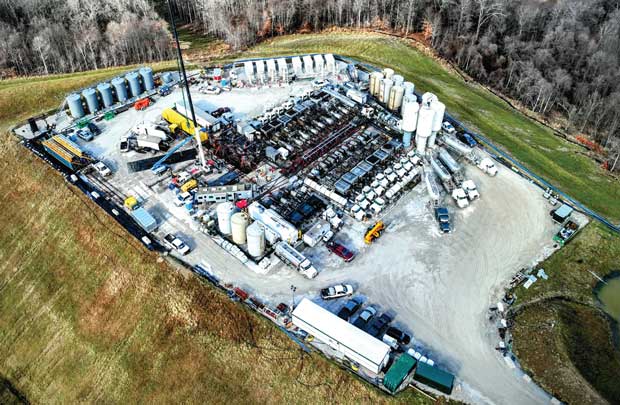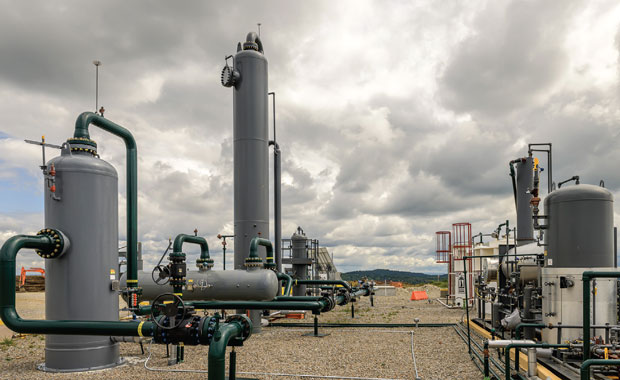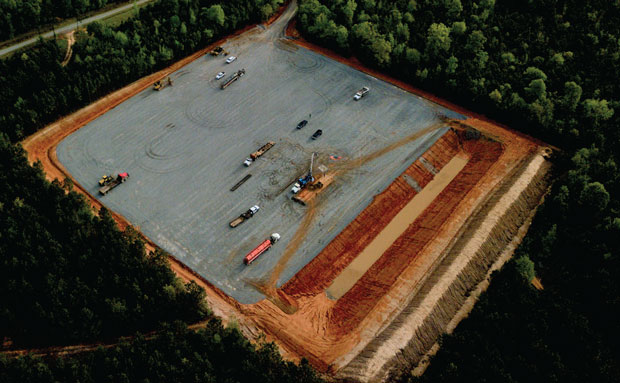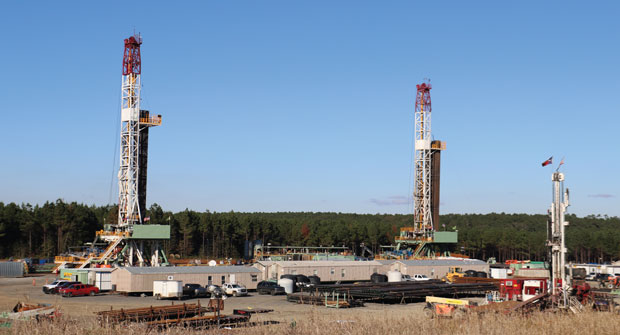
Gas-Focused Players Position For Opportunities As Market Conditions Improve
By Danny Boyd
There is no disputing that 2023 has been a tough year for natural gas prices, but as the stifling heat of August prepares to yield to the cool crispness of autumn, the coming seasonal shift serves as a reminder that natural gas is always one weather event away from a price rally.
With prices edging in the right direction in late summer, growth in U.S liquified natural gas export volumes and the anticipated completion of the Mountain Valley Pipeline, independent natural gas playmakers are finding reason for optimism as they look down the road to the start of a new winter heating season. They are working to improve operational efficiencies and rationalizing assets to sharpen their business models, all the while keeping a keen eye on LNG export growth.
In one week in late June and early July, 27 LNG vessels carrying 100 billion cubic feet of gas left U.S. terminals in Louisiana and Texas, according to the U.S. Energy Information Administration. Growing global demand and new capacity coming on line next year at the Golden Pass LNG facility at Sabine, Tx., and the Venture Global LNG terminal at Plaquemines, La., will further add baseline demand for domestic gas, boosting projected daily LNG exports from 12 billion cubic feet a day to 13.3 Bcf/d in 2024.
Appalachia To The Rockies
Appalachia producer Greylock Energy is leveraging its gas position to diversify its hydrocarbon mix and geographical footprint after a 2022 acquisition in the western Rockies, says Chief Executive Officer Kyle Mork.
“We remain active in the acquisitions market,” Mork says. “We generally look at anything and everything in Appalachia and in the western Rockies, but we continue to be open to opportunities outside those areas and have looked at several deals in other basins.”
The Charleston, W.V.-based, company last year acquired 1,400 producing, mostly vertical wells on 290,000 gross acres in Utah’s Uinta Basin and Wyoming’s Green River Basin. The assets boosted daily production by 50%, including a 2,000% increase in oil production. Still, natural gas accounts for some 90% of the company’s output.
The move also allowed Greylock to take advantage of better differentials, Mork continues. While differentials in Appalachia trade at a discount to Henry Hub, western Rockies gas has been trading at a premium this summer, he points out.
Although Greylock will not have capacity on Mountain Valley Pipeline, the added takeaway should have a positive impact on basin differentials across the Appalachian Basin, Mork observes. The announcement of the provision to complete MVP influenced moves in the futures market of $0.10/MMBtu for Appalachian gas, he says.
Appalachia-based Greylock Energy LLC is leveraging its gas position to diversify its hydrocarbon mix and geographical footprint after a 2022 acquisition in the Uinta and Green River basins. The company is performing recompletions in the Rockies this year in preparation for an accelerated development program, and continues its Marcellus long-lateral drilling program in Greene County, Pa.
“With MVP coming on line, I do not think it will fundamentally change things to the extent that we are suddenly going to get the equivalent to Henry Hub, as much as I would love that, but I do think it is going to be a net positive for us,” Mork assesses.
Several Rockies recompletions are being performed this year, including tapping into zones behind pipe, in preparation for an accelerated development program next year, he says.
After the acquisition, Greylock’s assets consist of 1.2 million acres, 6,700 wells, and 2,600 miles of pipeline, with much of its Appalachian production—which includes vertical production—coming from about 100 Marcellus wells in Greene County, Pa.
Drilling will continue in Greene County while the company prepares for potential development in other areas of Appalachia. Greylock continues to maximize lateral lengths where it can, averaging 8,500-9,000 feet this year, with averages dictated by lease configurations, Mork details.
“We have drilled several wells with laterals over 10,000 feet long and certainly see the benefit with increased estimated ultimate recoveries pretty much in linear fashion with lateral length,” he remarks. “But in Appalachia, it is just a little different ballgame because of how leases work here.”
Although Greylock continues to experiment with sand concentrations and loadings, Marcellus completion designs in Greene County have remained fairly consistent. Mork says 2,500 pounds of proppant per lateral foot is the sweet spot for stage spacings of 200 feet. The company has seen continued progress on surface logistics, including moving water and sand and frac crew design and rig up.
Midstream has been a major focus over the past few years, Mork notes, with recent opportunities including arrangements to supply gas to large manufacturers in the region.
Appalachian Powerhouse
Adding to the growing global market for natural gas, the approval of the last segment of the MVP pipeline system via the Fiscal Responsibility Act will add 2 Bcf/d of much-needed takeaway capacity out of the Appalachian Basin, allowing operators to collectively boost daily production to as much as 37 Bcf/d. Moreover, the summer heat has contributed to increased natural gas power burn, resulting in less-than-anticipated weekly injection rates into gas storage through mid-summer and helping Henry Hub prices climb from springtime lows.
Additional takeaway capacity from MVP is indeed welcome, but Appalachia could supply a lot more natural gas, says Toby Rice, chief executive officer of Pittsburgh-based EQT Corporation, the nation’s largest gas producer.
An ardent promoter of the potential of natural gas through EQT’s Unleash U.S. LNG campaign, Rice insists substantially more pipeline infrastructure will help the United States realize the full potential of the Marcellus Shale, a green energy resource.
It is one of the world’s biggest decarbonization opportunities, he says. With more pipeline capacity, Appalachia producers could produce an additional 30 Bcf/day for 30 years to meet global needs to replace coal and generate additional power for major global economies and impoverished third-world countries, according to Rice.
EQT Corp.’s midstream assets include 95 miles of owned and operated gathering systems. The company notes those midstream assets are linked to every one of Southwest Appalachia’s major long-haul interstate pipelines.
“If we want to meet stated climate objectives and timelines, if we want to provide energy security to our allies and the 3 billion people who live on less electricity than it takes to run the refrigerator, if we want to provide energy security to the 60% of Americans who live paycheck to paycheck, we have to do this fast,” Rice declares.
In the meantime, the company is adding assets and deploying “combo” development strategies to improve results on a massive 1.7 million acre-position in Pennsylvania, West Virginia and Ohio, where the overall rig count has remained steady over the past year.
In late July, EQT was awaiting regulatory approval of its pending acquisition of Tug Hill’s upstream assets and XcL Midstream’s gathering and processing business in a deal announced last fall.
The move would add 800 million cubic feet a day in Southwest Appalachia from 90,000 core net acres offsetting EQT’s existing core leasehold in West Virginia, Rice says.
EQT’s Midstream assets include 95 miles of owned and operated gathering systems connected to every major long-haul interstate pipeline in Southwest Appalachia. He says it also adds a 1 billion cubic feet equivalent a day rich-gas trunkline and a 3.5 Bcfe/d lean-gas trunkline.
The addition of Tug Hill would lower break-even cost by an additional $0.15/Mcf and add several hundred additional drilling locations, Rice reports. He explains that efficiencies from shaving $700 million from annualized costs over three years has reduced break-even prices to under $2.50/Mcf, creating more economic inventory as the company benefits from a hedge strategy providing optimum risk-adjusted upside to natural gas prices.
Large-scale combo development of multiple, adjacent pads in sequence further drives drilling efficiencies and speeds, Rice notes.
On June 28, EQT’s drilling department announced a 48-hour world record of 18,200 feet drilled on the SGL-179 No. 8H well, Rice points out. The record came after a record 24-hour footage of 12,318 feet on the same run. EQT’s wells continue to hit type curves and exceed expectations as the company focuses this year on boosting operations in West Virginia from 10% to about 25% of total activity, he adds.
For full-year 2023, EQT expects to turn about 120 wells on line, including 1 million-1.2 million horizontal feet, to hold production flat as it works to be net- zero on greenhouse gas emissions by 2025. Well design remains consistent, but with an emphasis on science, EQT continues to search for ways to optimize completions amid strong well performance, Rice concludes.
Haynesville Track Record
EnSight IV Energy Partners LLC, based in Shreveport, La., continues to build positions in the Haynesville Shale, prove up acreage through the drill bit, and package assets and sell them to established natural gas players looking for growth opportunities.
“We have a track record of success in doing that,” says President and Chief Executive Officer George Baldwin. “We have an investor base that is very supportive of that business model, and we have shown the ability to successfully execute this plan over and over again.”
A year ago, EnSight sold a 5,000 net-acre package with 42 MMcf net daily production in the core of the Haynesville Shale in Louisiana’s DeSoto, Bossier, Caddo and Webster parishes to Houston-based Tellurian Production LLC for $125 million. Included were high-quality, de-risked drilling locations.
After the sale, EnSight set out to repeat its success and established EnSight Haynesville Partners II to fund more work, Baldwin says. The fund closed in October with $92.3 million in commitments, mostly from existing investors happy with the earlier results, he updates.
After selling a 5,000 net-acre package with 42 MMcf net daily production last year for $125 million in the core of the Haynesville Shale, EnSight IV Energy Partners drilled nine wells through the first seven months of this year and was growing net production on pace to hit 100 MMcf/d by year’s end. EnSight IV is planning a 12-15 well 2024 drilling program.
“We are growing and improving our Haynesville/Bossier acreage position through leasing and trades, and are always, always, always looking for more to do,” Baldwin says.
The company is actively developing 4,500 Haynesville/Bossier acres in Louisiana’s Bossier, Webster, Bienville, DeSoto, and Red River parishes it kept from a position initially put together in 2020-21, he explains.
Ongoing projects also include continued development in Sligo Field in Bossier Parish with approximately 200 conventional wells mostly productive of gas and some liquids around Barksdale Air Force Base east of Shreveport. The position helped EnSight springboard into the Haynesville early on and includes behind-pipe opportunities in the Cotton Valley and Pettet and has 15 potential additional Haynesville locations, says Executive Vice President Chris Singletary.
Two DeSoto Parish Bossier Shale wells were being completed in July, and the company continues to search for more Haynesville and Bossier acreage to extend the play, according to Singletary.
EnSight has drilled nine wells so far this year and is in the planning stages for a 2024 program that may include 12-15 wells, he adds. Attractive initial production rates from the Haynesville include almost 23 MMcf/d from its Kervin well, he says.
EnSight’s net production is already back up to 90 MMcf/d since the sale to Tellurian and may eclipse 100 MMcf/d by year’s end, Baldwin reports. The company also is considering offering another package of assets this year or early next as additional LNG infrastructure to the south opens up more takeaway capacity and opportunity to Haynesville Shale players.
“We believe the globalization of the natural gas market is good for the domestic industry in general and the Haynesville/Bossier play in particular,” Baldwin says.
Extending The Boundaries
Presently running 11-12 rigs throughout the Haynesville Shale, Aethon Energy continues to prove up its 350,000-acre position to extend the play’s boundaries, with already prolific deep Bossier wells northwest of Houston.
Founded in 1990 with an initial focus on enhanced oil recovery, the Dallas company repositioned and embarked on the Haynesville as an operator in 2012, explains President Gordon Huddleston. Since then, Aethon has made 16 acquisitions and bolt-ons and remains interested in other growth opportunities. This year, the company has focused on growing production into its vertically-integrated midstream system, advancing its carbon capture initiatives and permitting projects on its Wind River Basin acreage in Wyoming.
“We focus on where can get the right value proposition and where we will be able to generate the type of returns we have generated historically,” Huddleston says.
Aethon Energy is running two rigs in Robertson County, Tx., where it has brought three wells on line producing as much as 30 MMcf/d with minimal pressure loss after initial production at double that rate. The company says its practice of tightening chokes to restrict IP flowback has produced flatter declines and greater EURs.
Aethon is excited about its results in Robertson County, Tx., which now has three wells producing and two active rigs in the area. These wells continue to flow up to 30 MMcf/d, with little pressure loss after initial production of about double that, he acknowledges. Aethon places less emphasis on 24-hour IP rates, with a practice of tightening chokes to restrict flowback that has produced flatter declines and greater EURs, Huddleston reports.
Altogether, the company has more than 20 years of drilling inventory, and this year also is delineating its position in the Shelby Trough.
By mid-year, the company has drilled more than 40 wells as part of a 2023 capital budget of more than $1 billion. Overall production is 3 Bcfe/d gross and 2 Bcfe/d net.
“Our plan was to reduce our rig count this year, and then move to more of a stable production profile,” Huddleston explains.
With a commitment to continually assessing and improving completion designs, the current standard is about 4,500 pounds of sand a lateral foot with cluster spacings varying according to the target, he says. Standardized designs “in the fairway” that constitute 80% of its Haynesville position can be updated as the company integrates successful completion experiments on the other 20%, Huddleston adds.
When eying expansion possibilities, Aethon weighs whether it can integrate new properties into its own extensive midstream gathering system that helps buttress cash flow in volatile cycles, he says.
The company indicates it gathers about 85% of its operated production, relying on other midstream players to accommodate the remainder of its output.
Aethon consistently works to reduce emissions and has lowered them 75% from 2016 to 2021, Huddleston says, and anticipates another 85% cut by 2031.
For other great articles about exploration, drilling, completions and production, subscribe to The American Oil & Gas Reporter and bookmark www.aogr.com.



















